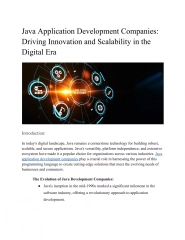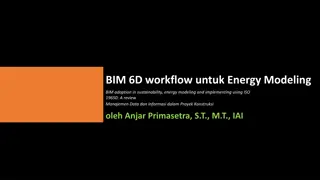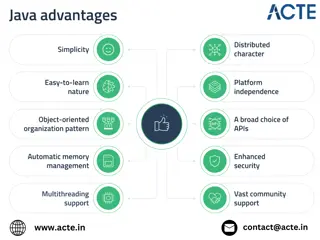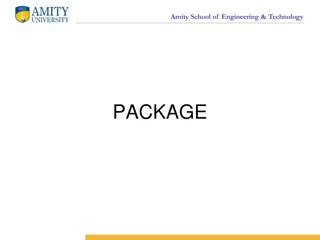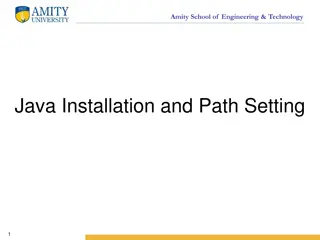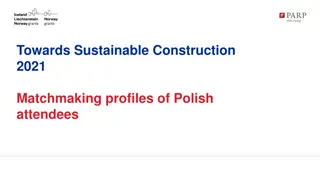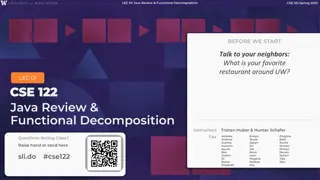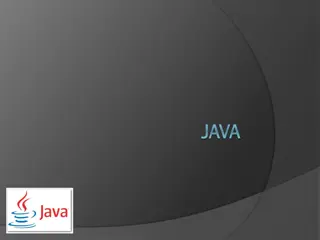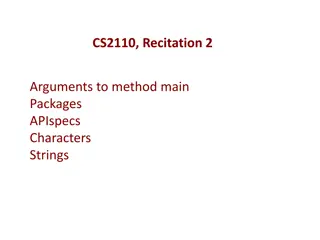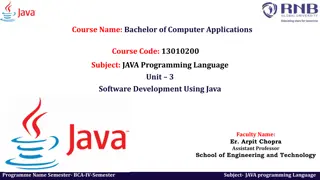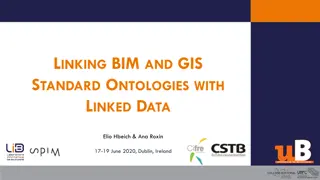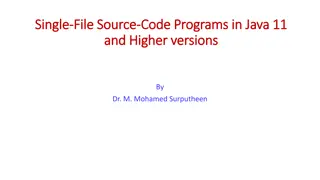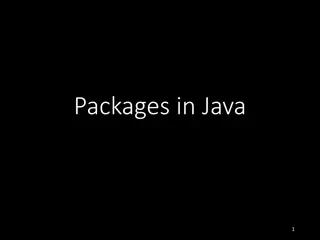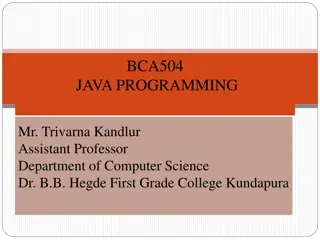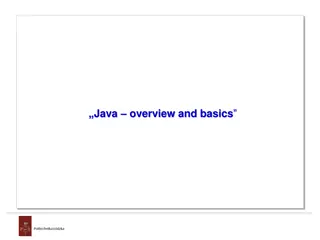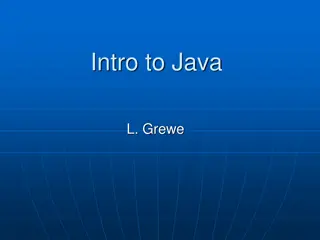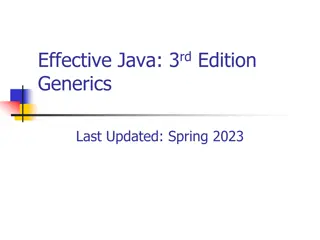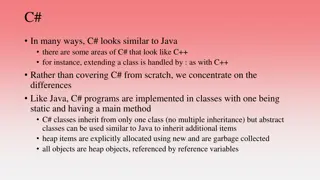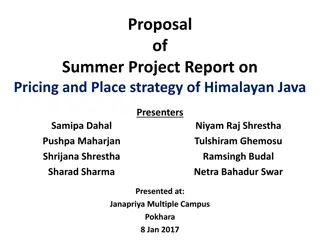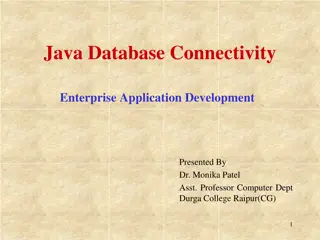
Understanding the Life Cycle of Java Applets
Explore the complete life cycle of Java applets, including initialization, start, stop, and destroy methods. Learn the differences between local and remote applets, along with their functionalities and usage. Dive into the world of applet development with this comprehensive guide.
Download Presentation

Please find below an Image/Link to download the presentation.
The content on the website is provided AS IS for your information and personal use only. It may not be sold, licensed, or shared on other websites without obtaining consent from the author. If you encounter any issues during the download, it is possible that the publisher has removed the file from their server.
You are allowed to download the files provided on this website for personal or commercial use, subject to the condition that they are used lawfully. All files are the property of their respective owners.
The content on the website is provided AS IS for your information and personal use only. It may not be sold, licensed, or shared on other websites without obtaining consent from the author.
E N D
Presentation Transcript
JAVA By Narayan Subedi
Local Applets A local applet is one that is stored on your own computer system. When your Web page must find a local applet, it doesn't need to retrieve information from the Internet-in fact, your browser doesn't even need to be connected to the Internet at that time
Local Applets <applet codebase="tictactoe" code="TicTacToe.class" width=120 height=120> </applet>
Remote Applets A remote applet is one that is located on another computer system. This computer system may be located in the building next door or it may be on the other side of the world-it makes no difference to your Java- compatible browser. No matter where the remote applet is located, it's downloaded onto your computer via the Internet. Your browser must, of course, be connected to the Internet at the time it needs to display the remote applet.
Remote Applets <applet codebase="http://www.myconnect.com/applets/" code="TicTacToe.class" width=120 height=120> </applet> In the first case, codebase specifies a local folder, and in the second case, it specifies the URL at which the applet is located.
Life Cycle of an Applet init: This method is intended for whatever initialization is needed for your applet. It is called after the param tags inside the applet tag have been processed. start: This method is automatically called after the browser calls the init method. It is also called whenever the user returns to the page containing the applet after having gone off to other pages.
Life Cycle of an Applet stop: This method is automatically called when the user moves off the page on which the applet sits. It can, therefore, be called repeatedly in the same applet. destroy: This method is only called when the browser shuts down normally. Because applets are meant to live on an HTML page, you should not normally leave resources behind after a user leaves the page that contains the applet.
Life Cycle of an Applet paint: Invoked immediately after the start() method, and also any time the applet needs to repaint itself in the browser. The paint() method is actually inherited from the java.awt.
Java I/O File: java.io.File An abstract representation of file and directory pathnames.
Java I/O Directories: java.io.File A directory is a File which can contains a list of other files and directories. You use File object to create directories, to list down files available in a directory. String dirname = "/tmp/user/java/bin"; File d = new File(dirname); // Create directory now. d.mkdirs();
I/O Stream Classes FileInputStream A FileInputStream obtains input bytes from a file in a file system. FileOutputStream A file output stream is an output stream for writing data to a File or to a FileDescriptor. FileReader Convenience class for reading character files. FileWriter Convenience class for writing character files. InputStreamReader
Byte Streams Java byte streams are used to perform input and output of 8-bit bytes. Though there are many classes related to byte streams but the most frequently used classes are , FileInputStream and FileOutputStream. Following is an example which makes use of these two classes to copy an input file into an output file:
Byte Streams import java.io.*; public class CopyFile { public static void main(String args[]) throws IOException { FileInputStream in = null; FileOutputStream out = null; try { in = new FileInputStream("input.txt"); out = new FileOutputStream("output.txt"); int c; while ((c = in.read()) != -1) { out.write(c); } }finally { if (in != null) { in.close(); } if (out != null) { out.close(); } } } }
Character Streams Java Character streams are used to perform input and output for 16-bit unicode. FileReader and FileWriter. Reads / Writes two bytes at a time. Input and output done with stream classes automatically translates to and from the local character set (internationalization ). So, more convenient than Byte Streams.
Character Streams import java.io.*; public class CopyFile { public static void main(String args[]) throws IOException { FileReader in = null; FileWriter out = null; try { in = new FileReader("input.txt"); out = new FileWriter("output.txt"); int c; while ((c = in.read()) != -1) { out.write(c); } }finally { if (in != null) { in.close(); } if (out != null) { out.close(); } } } }
Reading File import java.io.*; public class ReadFileExample { public static void main(String[] args) { File file = new File("D:/robots.txt"); FileInputStream fis = null; try { fis = new FileInputStream(file); } } } catch (IOException e) { } finally { } System.out.println("Total file size to read (in bytes) : " + fis.available()); int content; while ((content = fis.read()) != -1) { // convert to char and display it System.out.print((char) content); } e.printStackTrace(); try { } catch (IOException ex) { } if (fis != null) fis.close(); ex.printStackTrace();
Writing to File import java.io..*; public class WriteFileExample { public static void main(String[] args) { FileOutputStream fop = null; File file; String content = "This is the text content"; try { } catch (IOException e) { } finally { file = new File("d:/newfile.txt"); fop = new FileOutputStream(file); // if file doesnt exists, then create it if (!file.exists()) { file.createNewFile(); } // get the content in bytes byte[] contentInBytes = content.getBytes(); fop.write(contentInBytes); fop.flush(); fop.close(); System.out.println("Done"); e.printStackTrace(); try { } catch (IOException e) { if (fop != null) { } fop.close(); e.printStackTrace();
File Input Stream read() method Reads a byte of data from this input stream (InputStream class). This method blocks if no input is yet available. The methods returns the next byte of data, or -1 if the end of the file is reached.
RandomAccessFile The Java.io.RandomAccessFile class file behaves like a large array of bytes stored in the file system. Instances of this class support both reading and writing to a random access file. RandomAccessFile(File file, String mode)
Introduction to Java NIO Non-blocking I/O (usually called NIO, and sometimes called "New I/O") is a collection of Java programming language APIs that offer features for intensive I/O operations. Beginning with version 1.4 It supports a buffer-oriented, channel-based approach to I/O operations. Packagejava.nio NIO subsystem does not replace the stream-based I/O classes found in java.io. NIO buffers NIO data transfer is based on buffers (java.nio.Buffer and related classes). These classes represent a contiguous extent of memory, together with a small number of data transfer operations.
Distributed Application A distributed application is software that is executed or run on multiple computers within a network. These applications interact in order to achieve a specific goal or task. Traditional applications relied on a single system to run them. Even in the client-server model, the application software had to run on either the client, or the server that the client was accessing. However, distributed applications run on both simultaneously. The very nature of an application may require the use of a communication network that connects several computers: for example, data produced in one physical location and required in another location.
Distributed Application There are many cases in which the use of a single computer would be possible in principle, but the use of a distributed system is beneficial for practical reasons. For example, it may be more cost- efficient to obtain the desired level of performance by using a cluster of several low-end computers, in comparison with a single high-end computer.
Remote Method Invocation (RMI) Remote Method Invocation (RMI) allows a Java object that executes on one machine to invoke a method of a Java object that executes on another machine. This is an important feature, because it allows you to build distributed applications.
RMI Layers Stub and Skeleton Layer The stub and skeleton layer is responsible for marshaling and unmarshaling the data and transmitting and receiving them to/from the Remote Reference Layer Remote Reference Layer The Remote reference layer is responsible for carrying out the invocation. Transport Layer The Transport layer is responsible for setting up connections, managing requests, monitoring them and listening for incoming calls
RMI Mechanism Locate remote objects. Applications can use various mechanisms to obtain references to remote objects. For example, an application can register its remote objects with RMI's simple naming facility, the RMI registry. Communicate with remote objects. Details of communication between remote objects are handled by RMI. Load class definitions for objects that are passed around. Because RMI enables objects to be passed back and forth, it provides mechanisms for loading an object's class definitions as well as for transmitting an object's data.
RMI Registry Essentially the RMI registry is a place for the server to register services it offers and a place for clients to query for those services. RMI Registry acts a broker between RMI servers and the clients. A Simple Client/Server Application Using RMI This section provides step-by-step directions for building a simple client/server application by using RMI. The server receives a request from a client, processes it, and returns a result.
Java Network Programming Introduction to Network Programming The term network programming refers to writing programs that execute across multiple devices (computers), in which the devices are all connected to each other using a network. The java.net package of the J2SE APIs contains a collection of classes and interfaces that provide the low-level communication details, allowing you to write programs that focus on solving the problem at hand.
Java Network Programming TCP: TCP stands for Transmission Control Protocol, which allows for reliable communication between two applications. TCP is typically used over the Internet Protocol, which is referred to as TCP/IP. UDP: UDP stands for User Datagram Protocol, a connection-less protocol that allows for packets of data to be transmitted between applications. The speed for TCP is slower than UDP. UDP is faster because there is no error-checking for packets. In TCP, there is absolute guarantee that the data transferred remains intact and arrives in the same order in which it was sent. In UDP, there is no guarantee that the messages or packets sent would reach at all.
Java Network Programming IP Address : (Ex: 192.168.1.1) An Internet Protocol address (IP address) is a numerical label assigned to each device (e.g., computer, printer) participating in a computer network that uses the Internet Protocol for communication. Port Number: In TCP/IP and UDP networks, an endpoint to a logical connection. The port number identifies what type of port it is. For example, port 80 is used for HTTP traffic.
Java Network Programming Socket: A socket is one endpoint of a two-way communication link between two programs running on the network. A socket is bound to a port number so that the TCP layer can identify the application that data is destined to be sent to. An endpoint is a combination of an IP address and a port number. Every TCP connection can be uniquely identified by its two endpoints. That way you can have multiple connections between your host and the serve
Java Network Programming URL Itis an acronym for Uniform Resource Locator and is a reference (an address) to a resource on the Internet. A URL has two main components: Protocol identifier: For the URL http://example.com , the protocol identifier is http . Resource name: For the URL http://example.com , the resource name is example.com . java.net.URL Class URL represents a Uniform Resource Locator, a pointer to a "resource" on the World Wide Web. A resource can be something as simple as a file or a directory, or it can be a reference to a more complicated object, such as a query to a database or to a search engine.
Java Network Programming java.net.URLConnection The abstract class URLConnection is the superclass of all classes (HttpURLConncetion ) that represent a communications link between the application and a URL. Instances of this class can be used both to read from and to write to the resource referenced by the URL. In general, creating a connection to a URL is a multistep process using openConnection() and connect() The connection object is created by invoking the openConnection method on a URL. The setup parameters and general request properties are manipulated. The actual connection to the remote object is made, using the connect method. The remote object becomes available. The header fields and the contents of the remote object can be accessed.
Java Network Programming URL & URLConnection Example
Java Network Programming Creating a client/server application using TCP Sockets Creating a client/server application using UDP Datagram
Java Database Programming Relational Database Overview A database is a means of storing information in such a way that information can be retrieved from it. In simplest terms, a relational database is one that presents information in tables with rows and columns. A table is referred to as a relation in the sense that it is a collection of objects of the same type (rows). Data in a table can be related according to common keys or concepts, and the ability to retrieve related data from a table is the basis for the term relational database. A Database Management System (DBMS) handles the way data is stored, maintained, and retrieved. In the case of a relational database, a Relational Database Management System (RDBMS) performs these tasks.
Java Database Programming JDBC API JDBC API is a Java API that can access any kind of tabular data, especially data stored in a Relational Database. JDBC works with Java on a variety of platforms, such as Windows, Mac OS, and the various versions of UNIX. java.sql package
Java Database Programming Driver Manager and JDBC Drivers JDBC drivers implement the defined interfaces in the JDBC API for interacting with your database server. An individual database system is accessed via a specific JDBC driver that implements the java.sql.Driver interface. Drivers exist for nearly all popular RDBMS systems, though few are available for free. Sun bundles a free JDBC-ODBC bridge driver with the JDK to allow access to standard ODBC data sources, such as a Microsoft Access database. An easy way to load the driver class is to use the Class.forName() method: Class.forName("sun.jdbc.odbc.JdbcOdbcDriver");
Java Database Programming Driver Manager and JDBC Drivers When the driver is loaded into memory, it registers itself with the java.sql.DriverManager class as an available database driver. The next step is to ask the DriverManager class to open a connection to a given database, where the database is specified by a specially formatted URL. The method used to open the connection is DriverManager.getConnection() . It returns a class that implements the java.sql.Connection interface: Connection con = DriverManager.getConnection("jdbc:odbc:somedb", "user", "passwd");
Java Database Programming JDBC Driver Types JDBC driver implementations vary because of the wide variety of operating systems and hardware platforms in which Java operates. Sun has divided the implementation types into four categories, Types 1, 2, 3, and 4, which is explained below: Type 1: JDBC-ODBC Bridge Driver: Type 2: JDBC-Native API: Type 3: JDBC-Net pure Java: Type 4: 100% pure Java: Reference http://www.tutorialspoint.com/jdbc/jdbc-driver-types.htm
Java Database Programming Introduction to ODBC ODBC (Open Database Connectivity) is a standard programming language middleware API for accessing database management systems (DBMS). The designers of ODBC aimed to make it independent of database systems and operating systems. An application written using ODBC can be ported to other platforms, both on the client and server side, with few changes to the data access code. ODBC was originally developed by Microsoft during the early 1990s.
Java Database Programming Connecting Database using JDBC ODBC Driver
Web Programming Using Java Servlet APIs Introduction to CGI Common Gateway Interface (CGI) are programs run by the web server (at "server side"). CGI is a standard method used to generate dynamic content on Web pages and Web applications. CGI, when implemented on a Web server, provides an interface between the Web server and programs that generate the Web content.
Web Programming Using Java Servlet APIs Introduction to Web Server A Web Server is a computer system that processes requests via HTTP. The term can refer either to the entire system, or specifically to the software that accepts and supervises the HTTP requests. The most common use of web servers is to host websites, but there are other uses such as gaming, data storage, running enterprise applications, handling email, FTP, or other web uses.

